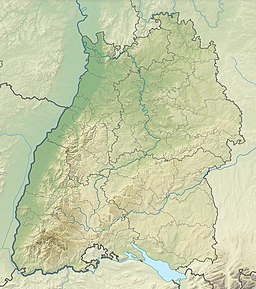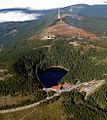
The Black Forest is a large forested mountain range in the state of Baden-Württemberg in southwest Germany, bounded by the Rhine Valley to the west and south and close to the borders with France and Switzerland. It is the source of the Danube and Neckar rivers.

Freiburg im Breisgau, commonly referred to as Freiburg, is an independent city in Baden-Württemberg, Germany. With a population of about 230,000, Freiburg is the fourth-largest city in Baden-Württemberg after Stuttgart, Mannheim, and Karlsruhe. The Freiburg built-up area had a population of 354,500 (2021). The population of the greater Freiburg metropolitan area ("Einzugsgebiet") was 656,753 in 2018. In the south-west of the country, it straddles the Dreisam river, at the foot of the Schlossberg.

Seewald is a municipality in the Freudenstadt district in Baden-Württemberg in southern Germany. It lies in the Black Forest. The source of the river Nagold is situated in the municipality. There is a dam in the river near the village Erzgrube, forming the artificial lake Nagoldsee. Erzgrube lies 550 m (1,804 ft) above sea level. Other subdivisions lie between 750 and 850 m above sea level in the midst of the forests. 90% of the area is covered with forests.
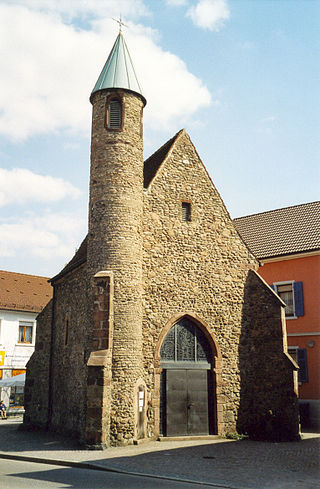
Achern is a town in Western Baden-Württemberg, Germany. It is located approximately 18 km southwest of Baden-Baden and 19 km northeast of Offenburg. Achern is the fourth largest town in the district of Ortenau (Ortenaukreis), after Offenburg, Lahr / Black Forest and Kehl.

The Schluchsee is a reservoir lake in the district of Breisgau-Hochschwarzwald, southeast of the Titisee in the Black Forest near Freiburg im Breisgau, Germany.

The Schauinsland is a mountain in the Black Forest with an elevation of 1,284 m (4,213 ft) above sea level. It is a popular destination for day trips. Due to the high amount of silver mining, it was previously known as "Erzkasten" ; the name "Schouwesland" first appeared in 1347. The mountain is located roughly ten kilometres south-east of Freiburg's city centre.

The Acher is a 53.6-kilometre-long river and right-hand tributary of the Rhine in the county of Ortenau, in the south German state of Baden-Württemberg. It flows in an northwesterly direction from the Black Forest to the Rhine, between the two rivers Rench to the south and the Oos to the north.
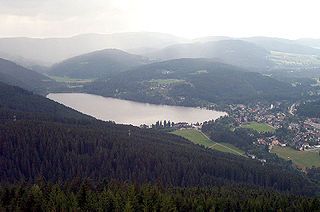
Titisee-Neustadt is a municipality in the district of Breisgau-Hochschwarzwald in Baden-Württemberg in southern Germany. It is made up of the six communities of Neustadt, Langenordnach, Rudenberg, Titisee, Schwärzenbach and Waldau.
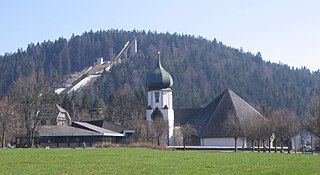
Hinterzarten is a resort village in the Black Forest, located in the southwest of the state of Baden-Württemberg, Germany. Although Hinterzarten is mostly famous for its ski jumping, it has many other tourist attractions.

Dietingen is a municipality in the district of Rottweil, in Baden-Württemberg, Germany.

Stegen is a municipality in the Breisgau-Hochschwarzwald district, Baden-Württemberg, Germany. It borders on the city of Freiburg, being about 8 km away as the crow flies, lying in the valley of the river Dreisam. The municipality includes three population centres: the town of Stegen and the villages of Eschbach and Wittental.
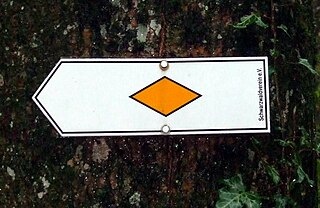
The Schwarzwaldverein was founded in Freiburg im Breisgau (Germany) in 1864, making it the oldest German hiking and mountaineering club. The Schwarzwaldverein has almost 90,000 members in 241 local chapters. Activities of the club include hiking, environmental protection, the promotion of local culture, trail maintenance, and family and youth work projects in the Black Forest.

The Schwarzwaldhochstraße or Black Forest High Road is the oldest and one of the best known themed drives in Germany. It is a part of the B 500 federal highway and leads over 60 km from Baden-Baden to Freudenstadt.

The Northern Black Forest refers to the northern third of the Black Forest in Germany or, less commonly today, to the northern half of this mountain region.

The Falkenfelsen(Falcon Rock) is a granite rock formation in the Northern Black Forest of Germany's Baden-Württemberg state. One side of the formation is a cliff about 200 feet (61 m) high. From the Schwarzwaldhochstrasse (Black Forest Highway), two hiking trails lead through the formation and end at the shelter Herta-hut. The platform has a view over the northern Black Forest, with the Hornisgrinde in the south, Bühlerhöhe in the northeast and the valley of the Upper Rhine on the west.

The Höllental in the Black Forest is a deep valley - in places like a gorge - in the state of Baden-Württemberg in Germany. The valley, which is about 9 km long, is located in the southern part of the Southern Black Forest Nature Park about 18 km southeast of Freiburg im Breisgau between Hinterzarten and Buchenbach-Himmelreich. The Rotbach stream runs through the valley. "Hölle" is the German word for "hell". In the narrow, dark valley, travellers almost felt like moving underground. The valley was the locale of the Battle of Emmendingen in 1796, part of the French Revolutionary Wars.

The Belchen, 1,414 metres (4,639 ft), or Black Forest Belchen is the fourth-highest summit of the Black Forest after Feldberg, Seebuck and Herzogenhorn. The municipalities of Münstertal, Schönenberg and Kleines Wiesental meet on the summit dome of Belchen which is located in the southwest German state of Baden-Württemberg.

Offenburg station is a railway station in Baden-Württemberg and has seven tracks on four platforms. Offenburg used to be a railway town and the station was of major economic importance to it. In recent years the maintenance facilities and much of the rail freight yards have been closed. The station is very centrally located within the city and is easily accessible by 18 different bus routes from the central bus station, 50 metres from the railway station.
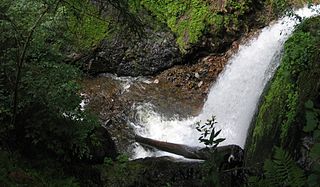
The Ravenna Gorge is a gorge in the Black Forest in southwest Germany. It is a narrow side valley of the Höllental, through which the Ravenna stream flows. A trail also runs through the ravine as part of the Black Forest Homeland Path. The roughly four-kilometre-long gorge runs from the Höllental up to the village of Breitnau on the plateau and lies within its municipal boundaries. The name of the gorge is probably derived from the French word ravine which means "gorge".
The Kunstpfad am Mummelsee is a sculpture path around the Mummelsee, which is located in the municipality of Seebach near Achern in the northern Black Forest in Baden-Württemberg (Germany). The sculpture path is 0,8 kilometres long is primarily used for nature and art walks.

